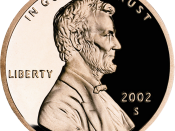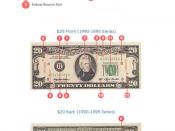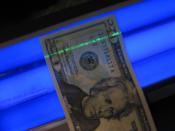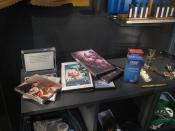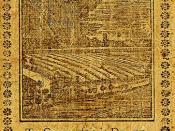I Last summer at a music store I was buying a guitar. The store was equipped with a counterfeit detection pen and scanner which many other stores use. As I was purchasing the guitar with cash, the employee took every dollar and passed it through the scanner. He was almost done until one of my $100 bills failed the counterfeit test. It set off an alarm and before I knew it, everyone was staring at me. I was extremely surprised and speechless because I know I did not intentionally give the store a counterfeit bill, but I had to stay for the authorities to get there. As I was being interrogated by the cops and the employees, the only credible reason, which was true, that I had was that the ATM machine where I got all my $100 bills gave me the fake. So I had to ride in the police car to the bank where I got my money and we looked at the ATM records for that morning and the surveillance tape.
Fortunately, the records show that I got them from the bank before I went to the store. However, unfortunately I did not get my $100 back, but that wouldn't matter compared to the $1200 fine I would have had to paid if I could not have proved my innocence.
II. This story shows that even in lesser situations, the counterfeiting of money has very harsh consequences.
A As expressed in the United States code: 1. Whoever, with intent to defraud, forges, counterfeits, or alters any security of the United States, shall be fined or imprisoned not more than fifteen years, or both (Federal Statutes).
2. Also, whoever, with intent or attempts to pass, publish, or sell, or intent to bring into the United States or keep in possession any forged, counterfeited, or altered security of the United States, shall be fined or imprisoned not more than fifteen years, or both (Federal Statutes).
3. Likewise, the modification or forgery any kind of coin over 5 cents in value are exposed to the same penalties as paper currency counterfeiting.
B. These civil codes show that the United States government is committed to zero tolerance and is determined to examine every individual counterfeiting case. Each counterfeiting case, no matter how large or small, carries the critical punishment of incarceration and fines.
III. However, millions of counterfeit dollars are dispersed in the United States daily and is one of the oldest crimes in history because it has been so easy to get away with in the distant and recent past.
A. During the mid 1800's, there were approximately 1600 banks in the United States and each one printed their own currency. Consequently, over one-third of money in circulation was counterfeit (US Sec. Serv).
B A national currency was finally incorporated, but did not curve the counterfeit dilemma. In 1865, the Secret Service was assembled to study and examine counterfeit actions.
IV. But just as the prevention technology began to revolutionize, so has the counterfeit technology. The development of counterfeiting money has changed from primitive printing such as professional penmanship and printing press to color Xerox, computer imaging, and inkjet printers (US Sec. Serv.). Advanced technology in the office machine copiers has made it conceivable for even untrained operators to generate high-resolution color replicas. Because the competence needed for counterfeiting in the past are not essential to be successful today, computer related counterfeiting has increased from nearly nothing to 40% in the last decade (Jascon).
V. But, there are federal agencies and personal observances that are created to hinder criminals that intend to print and use counterfeit money.
A. As stated before, when the Secret Service was established they were not assigned to protect the president and other heads of state, which began in 1901. Their purpose was and still is to defend the economy by being the first line of obstruction by seizing counterfeit money.
B. Also established to hinder criminals was the Bureau of Engraving and Printing This department uses complex procedures and techniques to avert successful counterfeiting. Since the modification of paper currency a few years ago, most United States currency has been revised to include more security features such as"æ 1. Real money has a very specific, "life-like"àpicture of the person on the front 2. " " is made of a high grade paper made of cotton and linen for the tough feel, also including a watermark assembled into it 3. " " has clear, complex borders and ink that can be rubbed off 4. " " uses numerous microprinting techniques.
C. Finally, if you do identify counterfeit money, you should get in touch with the authorities and carefully safeguard the fake note for fingerprints. Over 130 million dollar bills were confiscated last year and most of the people that were caught were as a matter of fact normal, decent citizens who obtain the money earlier and in turn used it themselves (Jascon). However, just because you were a victim of someone else's criminal intent does not mean you won't get prosecuted. Unless you have a credible account of the situation, which luckily I did, any attempt or effort to using fake money, conscience or unconscience of the fact it is fake, will get you at least a stiff fine or in extreme cases, prosecution.

